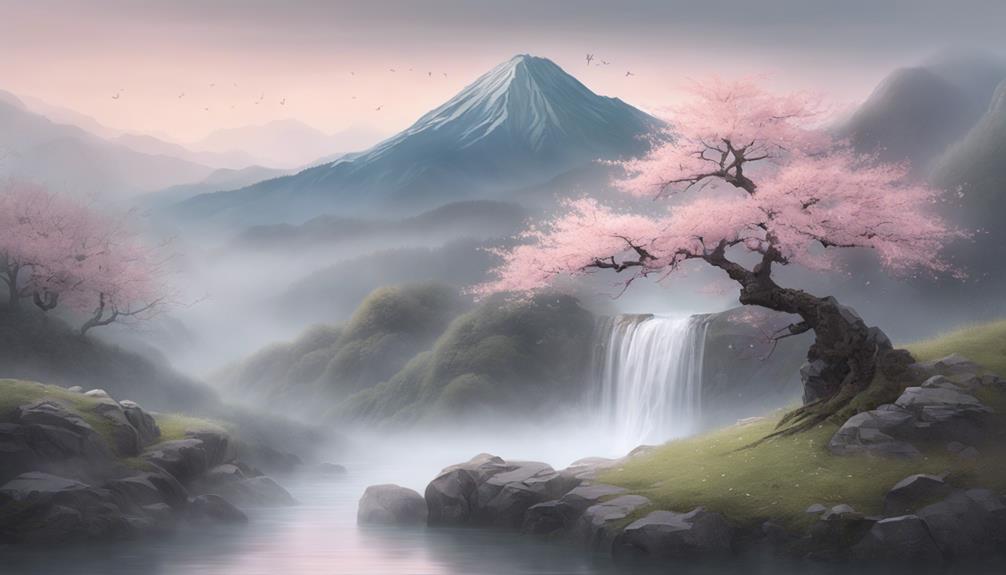As you venture into the domain of haiku, you'll discover a nuanced poetic form that captures nature's essence in a delicate balance of 5-7-5 syllables. Traditional Japanese haiku masters like Bashō and Buson pioneered this art, infusing it with Zen Buddhist and Shintoist influences. The 5-7-5 structure distills complex ideas into few words, reflecting the simplicity and harmony of nature. Haiku invites you to slow down, observe, and connect with the natural world on a deeper level. As you explore further, you'll unravel the intricate web of relationships between nature and human experience, and uncover the secrets of this timeless poetic form.
Understanding Haiku Origins
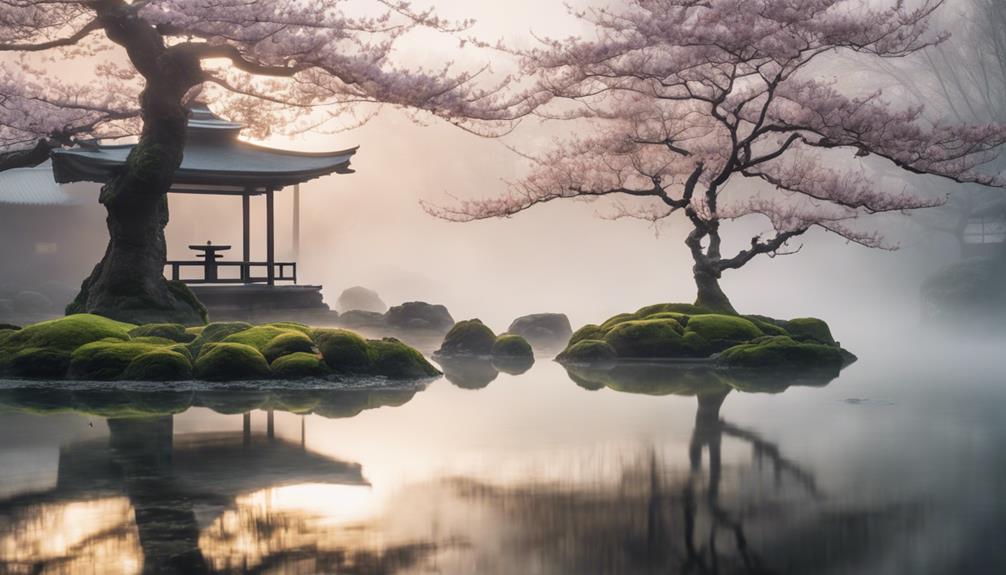
When you explore the world of haiku, it's essential to grasp that this traditional form of Japanese poetry originated in the 17th century, when poets like Matsuo Bashō and Yosa Buson pioneered the art of capturing nature's essence in 5-7-5 syllables. This historical context is vital to understanding the cultural roots of haiku. The genre evolved from tanka, a longer form of Japanese poetry, and was heavily influenced by Zen Buddhism and Shintoism. The 17th century was a time of great cultural and artistic transformation in Japan, and haiku emerged as a unique form of poetic expression. The genre's early masters, such as Bashō and Buson, drew inspiration from nature and the changing seasons, using imagery and suggestion rather than direct statement. By examining the cultural roots and historical context of haiku, you'll gain a deeper appreciation for the nuances and complexities of this traditional form of Japanese poetry.
Nature's Role in Haiku Poetry

In haiku poetry, you'll find that nature's presence is omnipresent, with seasonal references (kigo) and imagery drawn from the natural world serving as a backdrop for poignant, introspective moments. This emphasis on nature isn't merely decorative; it's a deliberate choice that underscores the interconnectedness of human experience and the natural world. As you explore into haiku, you'll discover that the genre fosters a profound sense of earthly connections, encouraging you to tune into the rhythms and cycles of the earth.
This natural spirituality is not about worshipping nature, but about recognizing the intricate web of relationships that binds us to the land, the seasons, and the creatures that inhabit it. Haiku poets often use natural imagery to convey emotions, ideas, and insights, subtly revealing the ways in which our inner lives are mirrored in the outer world. By examining the intersections of human and natural worlds, haiku poetry invites you to cultivate a deeper appreciation for the intricate, interconnected web of life. As you engage with haiku, you'll find that nature's presence becomes a catalyst for introspection, self-discovery, and a more nuanced understanding of your place within the world.
The 5-7-5 Syllable Pattern
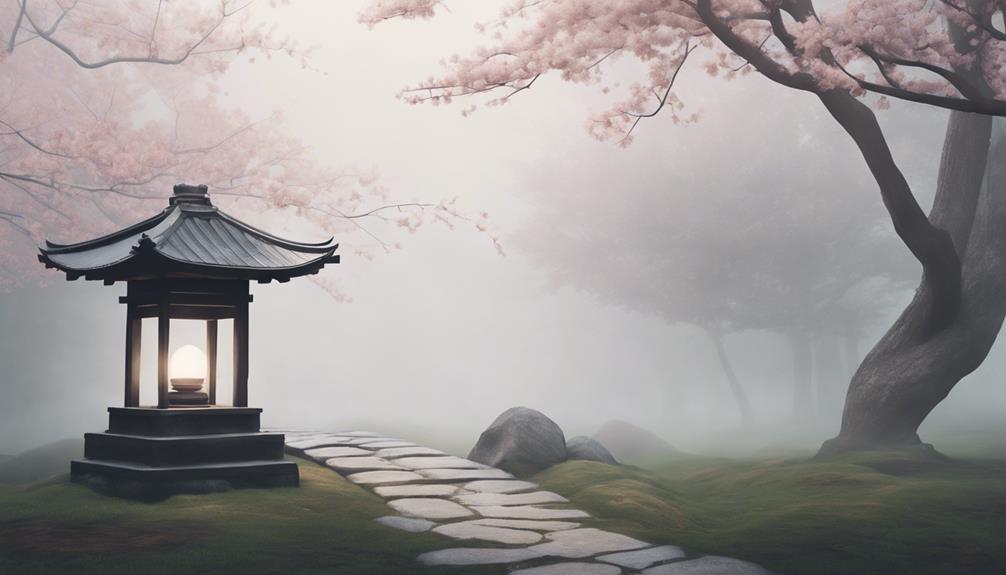
As you explore the nuances of haiku poetry, you'll discover that the traditional 5-7-5 syllable pattern serves as a structural framework, subtly guiding the poet's hand to distill complex ideas and emotions into a few, well-chosen words. This pattern is not merely a rigid formula, but a delicate balance that allows the poet to convey the essence of nature with precision and elegance.
The significance of each syllable cannot be overstated, as each one carries a distinct weight in conveying the poet's intended meaning. The carefully crafted arrangement of syllables allows the poet to evoke a sense of wonder, serenity, or contemplation, inviting the reader to immerse themselves in the natural world. The cultural influence of Japanese aesthetics is evident in the 5-7-5 pattern, which reflects the Zen Buddhist emphasis on simplicity, harmony, and balance. By embracing this traditional structure, haiku poets can tap into the rich cultural heritage of Japan, while also conveying the timelessness and universality of nature's beauty.
Capturing Moments in Time
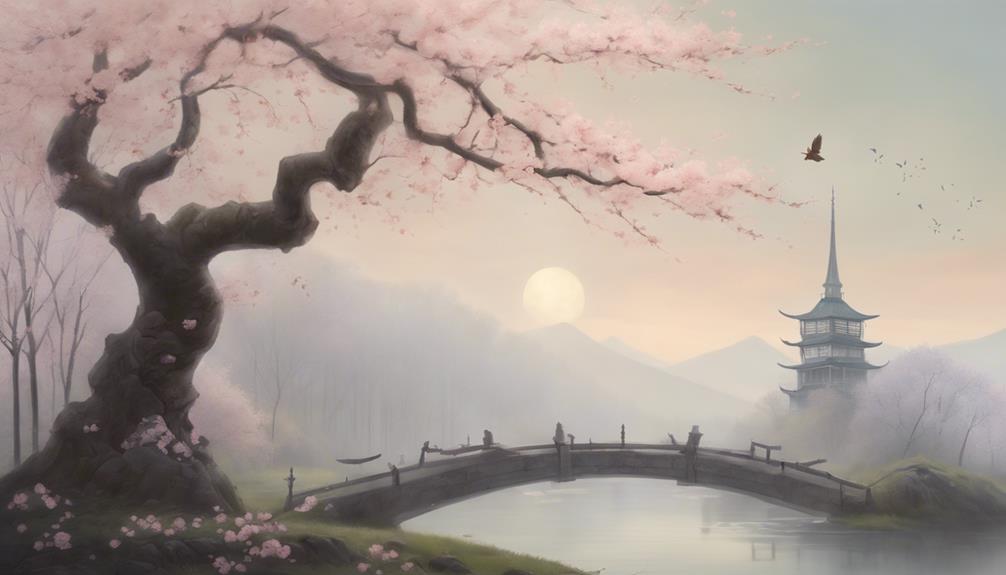
How do explore fleeting moments in nature – a sunrise, a snowflake's descent, or a leaf's rustle – become crystallized in the haiku poet's mind, awaiting translation into the precise, evocative language that captures their essence? As you investigate into the world of haiku, you'll discover that these ephemeral moments are the very fabric of this ancient art form. Fleeting beauty, often lost in the chaos of everyday life, is distilled into timeless moments that transcend the mundane.
In capturing these moments, the haiku poet must first attune themselves to the subtleties of nature. It's a process of quiet observation, where the poet's mind becomes a receptive vessel, awaiting the whispers of the natural world. As you practice this art, you'll find that the boundaries between observer and observed begin to blur, allowing the essence of the moment to seep into your consciousness. It's here, in this liminal space, that the haiku poet weaves a tapestry of words, carefully chosen to evoke the fleeting beauty of the natural world.
The Importance of Imagery

Your own perception of the natural world is heightened as you explore the world of haiku, where the poet's masterful use of imagery becomes the key to revealing the essence of the fleeting moment. Through sensory exploration, haiku poets invite you to engage with the natural world in a more intimate way, encouraging you to investigate and appreciate the intricate details that often go unnoticed. Vivid descriptions of nature's beauty are woven into the fabric of haiku, transporting you to a world of wonder and awe. The poet's use of imagery doesn't merely describe a scene; it evokes a sensory experience, drawing you into the moment. As you explore further into the world of haiku, you'll find yourself becoming more attuned to the subtleties of nature, and your appreciation for its beauty will grow. By leveraging the power of imagery, haiku poets create a shared experience, allowing you to connect with the natural world on a deeper level.
Simple Language, Deep Meaning
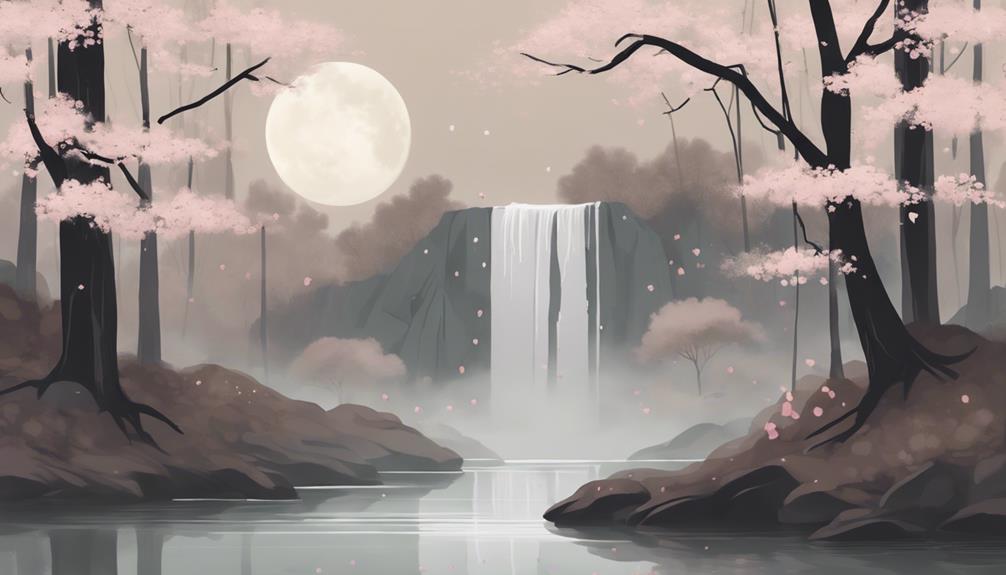
While haiku's concise structure might lead you to expect simplicity, it's precisely this brevity that belies a profound depth, for in the carefully chosen words, a world of meaning awaits discovery. As you explore the domain of haiku, you'll find that the simplicity of language belies a profound complexity of thought. The poet's masterful use of words creates a lyrical tone, imbuing the haiku with poetic nuances that invite contemplation.
In this subtle dance of language, every word, every pause, and every syllable is deliberate, conveying a depth of emotion and insight that's both intimate and universal. The simplicity of the haiku's language, in fact, serves to heighten the intensity of the experience, allowing you to tap into the poet's inner world. As you read, you'll begin to appreciate the subtle interplay of meaning and sound, and the way the poet's careful choices evoke a world of feeling and thought.
Haiku Masters and Their Works
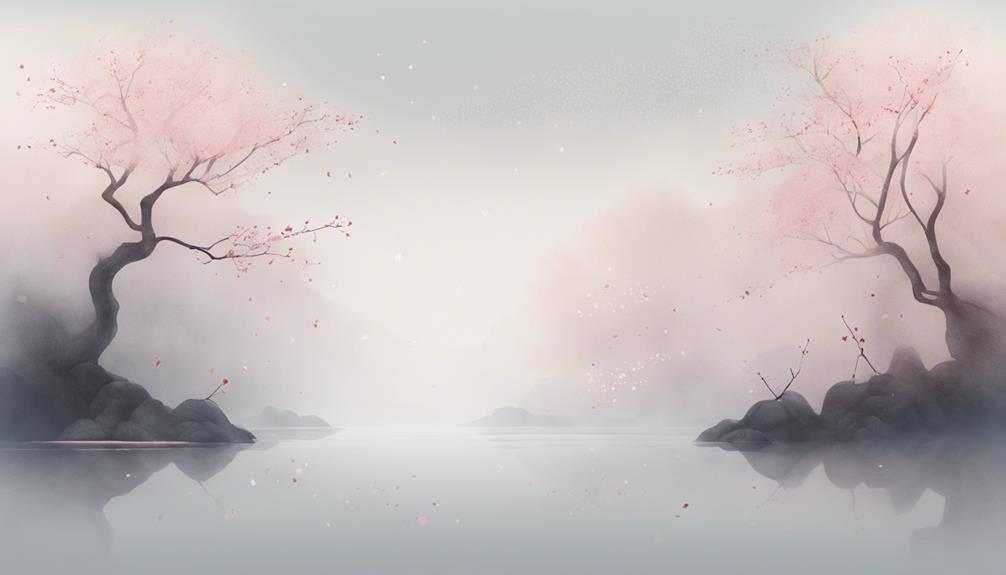
In the realm of haiku, a few masters have emerged, their works exemplifying the perfect harmony of simplicity and depth, as they weave intricate tapestries of meaning from the very fabric of nature. As you explore the world of haiku, you'll uncover the profound impact of these masters on the development of haiku movements. You'll find that their works not only mirrored the cultural significance of their time but also continue to influence contemporary haiku writing.
Masters like Bashō, Buson, and Issa have left an indelible mark on the haiku tradition. Their innovative approaches to haiku writing, such as Bashō's focus on the beauty of nature and Buson's use of imagery, have shaped the genre. You'll observe how their works convey a sense of timelessness, transcending cultural boundaries to speak to universal human experiences. As you explore the works of these masters, you'll gain a deeper understanding of the cultural significance of haiku and its continued relevance in modern times.
Writing Haiku, a Beginner's Guide
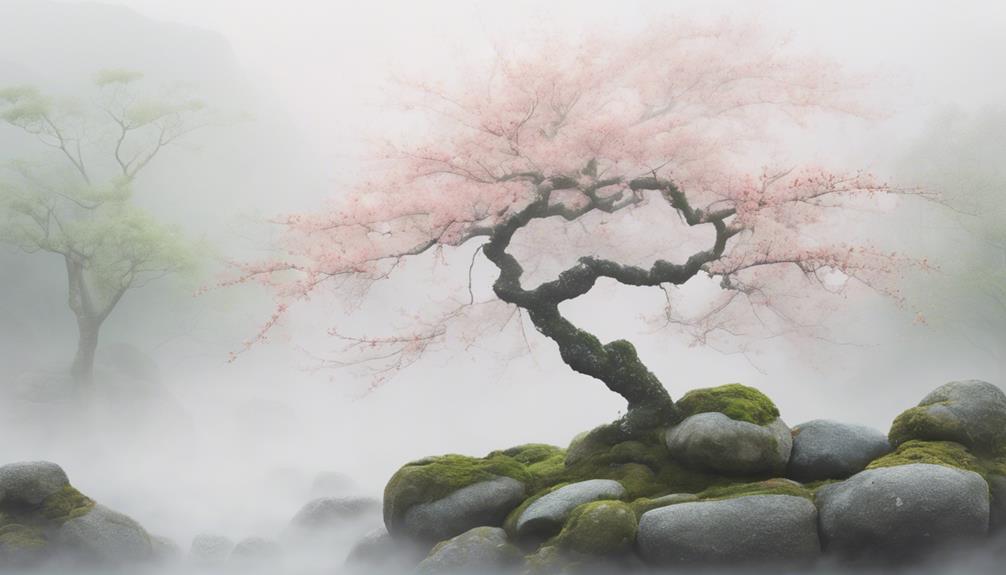
As you embark on the journey of writing haiku, it is important to understand the fundamental principles that govern this traditional form of Japanese poetry. You must grasp the delicate balance between nature, imagery, and simplicity. To overcome writer's block, start by brainstorming haiku prompts that evoke a sense of wonder or curiosity. Ask yourself, 'What season am I in? What natural elements surround me?' Perhaps a blooming flower or a gentle breeze sparks inspiration.
As you compose your haiku, remember to adhere to the 5-7-5 syllable structure. This constraint may seem challenging, but it is necessary to capturing the essence of haiku. Don't be afraid to experiment with different phrases or word choices to convey your intended meaning. When stuck, revisit the works of renowned haiku masters, analyzing their use of language and imagery. By embracing the principles of haiku and cultivating a sense of awareness, you'll find that your writing flows more effortlessly, and the haiku form begins to reveal its subtle beauty.
Haiku in Modern Times

Your exploration of traditional haiku principles has laid the groundwork for considering the form's evolution in contemporary contexts, and you're likely wondering how this ancient art form adapts to the complexities of modern life. As you venture into the domain of haiku in modern times, you'll discover that the traditional 5-7-5 syllable structure remains, but the medium and message have undergone significant transformations. The rise of social media has given birth to a new breed of haiku enthusiasts, who now share and engage with haiku on digital platforms. This digital haiku culture has not only increased the form's visibility but also enabled real-time feedback and collaboration. Social media haiku, often accompanied by visually striking images, have become a staple of online creative expression. As you navigate this modern haiku landscape, you'll notice that the emphasis has shifted from the solitary, nature-inspired musings of traditional haiku to a more communal, technology-driven experience.
Finding Inspiration in Nature

Nature's subtle nuances, from the morning dew's gentle kiss on the grass to the fiery hues of a sunset, have long been the haiku poet's trusted muse, and you'll find that cultivating a deeper connection with the natural world is essential to crafting authentic, evocative haiku. As you explore the domain of haiku, you'll discover that seasonal observations are a rich source of inspiration. Pay attention to the way the light changes with the seasons, how the air smells, and the sounds that fill the atmosphere. These subtle cues can spark a haiku that resonates deeply with readers. Environmental prompts, such as the rhythmic lapping of waves or the rustling of leaves, can also serve as potent catalysts for your haiku. To tap into this inspiration, take time to slow down, observe, and listen to the natural world. Record your impressions, sensations, and emotions in a journal or sketchbook, and let these observations simmer in your mind, allowing them to percolate into haiku that capture the essence of nature.
Frequently Asked Questions
Can Haiku Be Written in Languages Other Than Japanese?
As you wander through the garden of language, the petals of poetry unfolding before you, you ponder: can haiku bloom in tongues other than Japanese? Indeed, they can. Cultural adaptation has allowed haiku to transcend linguistic limitations, taking root in languages worldwide. While the essence of haiku remains, its form adapts to new linguistic soil, often yielding innovative, hybrid forms that blend traditional spirit with modern flair.
How Do I Handle Seasonal References in Modern Haiku?
As you craft modern haiku, handling seasonal references requires sensitivity to cultural nuances. You'll need to balance preserving traditional seasonal authenticity with adapting to contemporary contexts. Avoid forced or clichéd references; instead, infuse your haiku with subtle, nuanced touches that evoke the essence of the season. By doing so, you'll create haiku that resonate with modern readers while honoring the genre's roots.
Are Haiku Only Meant to Be Written in the Present Tense?
Your writing is a canvas, and verb conjugation is the brush stroke that paints a vivid picture in the reader's mind. When it comes to haiku, you might wonder if you're confined to the present tense. Not necessarily. While traditional haiku often employ the present tense to evoke a sense of immediacy, modern haiku can experiment with tense consistency, blending past, present, and future to create a nuanced narrative.
Can Haiku Have a Humorous or Ironic Tone?
As you explore the world of haiku, you may wonder, can these concise poems convey humor or irony? The answer is yes. In fact, a witty juxtaposition or a playful irony twist can elevate your haiku, making it more engaging and thought-provoking. By incorporating these elements, you can create a nuanced, clever haiku that subverts expectations and leaves the reader smiling or pondering.
Is It Necessary to Include a "Season Word" in Every Haiku?
You may wonder if including a season word in every haiku is necessary. Traditionally, it's a requirement, but modern haiku often deviate from this rule. The season word, known as kigo, holds cultural significance in Japanese haiku, as it grounds the poem in time and space. While it's not essential to include one in every haiku, doing so can add depth and nuance to your poem, connecting it to the natural world.
